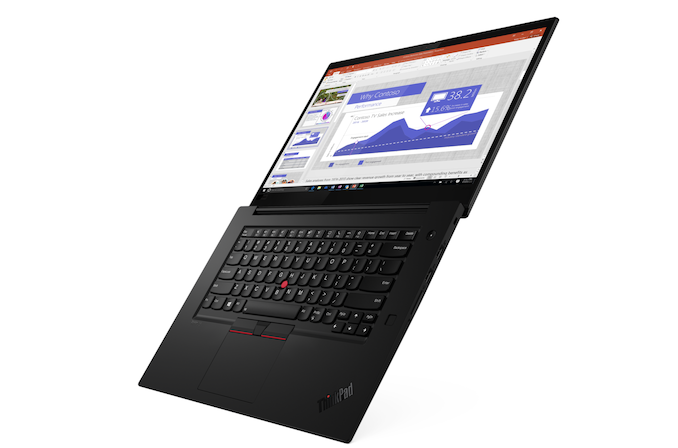Lenovo Unveils ThinkPad X1 Extreme Gen3: 45 W Core i9, 15.6-inch, 1650Ti
by Dr. Ian Cutress on June 17, 2020 9:00 AM EST_678x452.png)
For the high-performance commercial space, the line of Extreme Lenovo ThinkPads is a popular choice. For the current generation, Lenovo is unveiling a new X1 Extreme Gen3 version specifically for those commercial users that need performance from both the CPU and GPU in a typical ThinkPad style design. Highlights include the Intel Core-H series processor, the optional NVIDIA GeForce 1650Ti graphics, a 600-nit 15.6-inch display, as well as Wi-Fi 6 capabilities and an optional Cat16 LTE modem.
The new ThinkPad rotates out to a full 180-degree stance, with the bottom of the screen helping left the laptop to create airflow when at a more userfriendly angle. The X1 Extreme Gen3 will have a multitude of ports, including a card reader, two Type-A ports, two Type-C ports, a built in full-sized HDMI port, a 3.5mm jack, and Lenovo’s custom power connector. The company hasn’t released all the specifications yet, so we might expect to see Thunderbolt 3 support and additional Type-C charging perhaps.
New to some of Lenovo’s designs is its new Ultra Performance Mode, which is set to be exclusive to the Extreme and the ThinkPad P series. This will cause the system to enable higher power limits and higher thermal limits, as well as locking the hardware in at high frequencies, such that when it is critical for a render to complete on time or for a VR experience to not drop, these systems are capable (noise and thermals permitting). It will be interesting to see what this does above the standard Windows Ultimate Performance power mode.
Unfortunately Lenovo isn’t releasing too many details on its new X1 Extreme Gen3 just yet, indicating that it was perhaps planning to show an early engineering sample at what would have been the traditional Computex trade show a couple of weeks ago. The company states that the ThinkPad X1 Extreme Gen3 will be available from July, Price TBD.







_thumb.png)
_carousel_thumb.png)
_carousel_thumb.png)
_carousel_thumb.png)








22 Comments
View All Comments
weilin - Wednesday, June 17, 2020 - link
I think Lenovo has a similar issue to Msft in this respect. Diverge the product line feature set... or stay with one provider.ICL shipped with integrated Thunderbolt, and yet the Surface Pro 7 has it disabled... I wonder if that's because of the Ryzen Surface Laptop 3. Until we get to USB4, Thunderbolt is incompatible with AMD chipsets. Msft had to make a decision to omit Thunderbolt on their 15" flagship Surface Laptop... Or disable it across the board for feature parity across their whole product line (SB3, SL3, SP7).
I wonder if this a similar story for Lenovo... Creating a AMD version of X1 E would result in the loss of Management Engine and Thunderbolt (and other things). For the T series, there might be enough buyers to be worth the product line split and additional engineering costs to develop a separate line, but X1 E might be harder to say...
grant3 - Friday, June 19, 2020 - link
Thunderbolt is disabled on surface devices because some executive was paranoid about it possibly being a malware/hack vector.jeremyshaw - Wednesday, June 17, 2020 - link
Get the P1. No X1 tramp stamp.Also, it's not a deliberately lifting hinge for any screen angle that is useful. It's the same problem the older X1 carbons (no clue about the 7th/8th gen), E series, etc all faced. The backside of the screen ends up contacting the desk surface when the screen is open > ~150 degrees or so. Just poor design and oversight, but what we have come to expect from Lenovo.
tokyojerry - Wednesday, June 17, 2020 - link
Being unfamiliar with a P1, I am curious to know why a P1 would be preferred over the X1. I previously owned an X1 Extreme and sold it. I would also like to have AMD 4000-series as well so I wonder if there will be an AMD version of the P1.My most demanding task is video NLE production with BlackMagic's DaVinci Resolve or similar. Thus a dGPU is also desired. For external connectivity, I would like to have thunderbolt 3 ports, but that's not realistic with AMD and USB4 isn't a reality yet. I can live with USB-C 3.2 for the interim so long as there are dual M.2 slots.
jeremyshaw - Thursday, June 18, 2020 - link
It's purely a cosmetic decision. Lenovo backed down this time, but they were originally planning on a massive X1 logo across the back of the lid. Instead, they just moved it up to the Thinkpad logo area.I agree on the USB4 part, but USB4 doesn't require TB3 tech integration or even 40Gbps operation. The spec (already published, and freely available [unlike VESA Displayport, for example]) notes both as optional features. Yay. Hopefully AMD implements the real deal, on the SoC die itself (same for the desktop CPUs, where the Zen2 I/O die currently has a couple of USB 3.2 gen{?} controllers, with the rest coming from the Southbridge).
close - Thursday, June 18, 2020 - link
While I find that X1 logo on the back of the lid pretty garish I would definitely not go for the P1 just for this.olafgarten - Thursday, June 18, 2020 - link
I don't know why the moved it from it's current location. On the Gen 2 it's much smaller and on the opposite cornerSirKnobsworth - Wednesday, June 17, 2020 - link
You can actually see the Thunderbolt logos on there, so yes, TB3 #confirmedvol.2 - Wednesday, June 17, 2020 - link
how is the 1650ti extreme?lmcd - Wednesday, June 17, 2020 - link
We still haven't seen a single AMD H-series laptop with solely integrated graphics. I don't know if that's a coincidence, but regardless it doesn't seem to be an OEM priority. This sort of device would be a good candidate to include such a configuration.